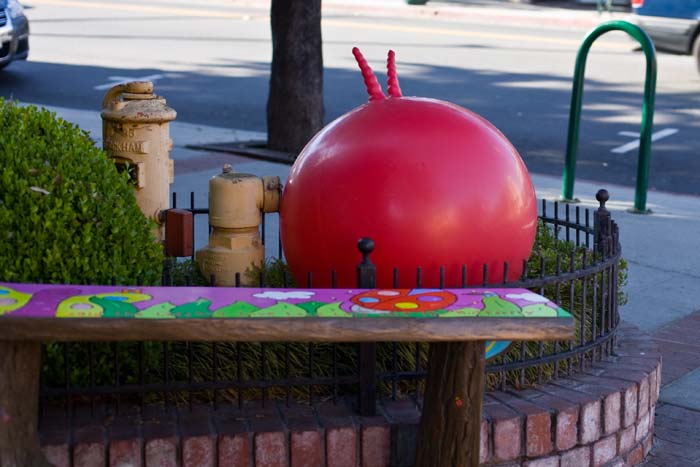
Random Acts of Cosmic Whimsy
by Jetse de Vries

The Multiverse is a weird, weird place.
Multitudes weirder than most suspect.
Some, though, do have an inkling.
While for a rare few it’s not quite weird enough...
***
Recipe for a Time Machine.
Ingredients:
→One Kerr-Newman black hole
→Highly advanced nanotechnology
→A reliably functioning, self-correcting
Entangled Particle Information
Transmitter (EPIT-link)
→A budding, space-faring civilisation.
Preparation:
Take one Kerr-Newman black hole of the smallest possible size and put it in a geostationary orbit of the home planet of the space-faring civilisation. Place a space station at the closest safe distance from it.
Develop nanobots with a nano propulsion, a quantum computer as CPU, and a self-correcting EPIT-link. Send nanobot to Kerr-Newman black hole, and make it run Closed-Timelike-Loops by moving in and out of the hole in the ring singularity via a highly elliptical orbit. The temporal jump of each loop depends on the time spent in the hole, so the temporal displacement of the nanobot can be decided by taking the number of the largest possible jumps and fine-tuned by a single, well-timed final jump.
Once in the desired time period, the nanobot must either find some raw material for the fabrication of a small re-entry craft (as nanobots are very prone to an atmosphere’s turbulence), or take the very bumpy ride down to the planetary surface and fabricate a small plane to take it to the desired location.
Once on the desired spot—in a concealed place—the nanobot can multiply and gather enough raw materials for the fabrication of the human clones for the time travellers to be transported into by means of its EPIT-link. Once safely installed in their clone bodies, the time travellers are ready to begin their—at times esoteric—tasks. Enjoy!
Note : most civilisations that have developed nanotechnology and EPIT-links have transcended into Matrioshka Brains, and have no need to investigate their own pasts, nor their own future, as the bandwidth of the link to the future is much too small to be of any practical use.
For more weird and wondrously impractical recipes check out:
→How to become God in your own Universe, see: Solipsism for beginners
→A Virtual Reality made exactly to order, see: Escapism for the slightly advanced
→Tweaking the basic constants, see: Creationism for experts
→Searching for the real Theory of Everything, see: Infinite regression for the over-focused.

The Mona Lisa was stolen. A cryptic note was attached on its empty spot at the Louvre, reading:
Art, in fact
alienates hitmen
contrasts and shades
as if SF, you tomato,
lights the dark
obscurity, when theirs
more in tiny details
than just the devil
or the deep black sea
The press had a field day, while all field agents of Paris’s gendarmerie, France’s Sécurité National, and Interpol were called in. This was a matter of national pride. In the following weeks, though, not a single clue—apart from the nonsensical note—was found. It looked as if the Mona Lisa had just vanished into thin air. The ‘crime of the century’ began to disappear from the front pages and prime time news as another event took centre stage...

Meanwhile, in Interpol’s hi-tech department in Glasgow, agents Watt and Krikksen are called into the research department. Hu—first name classified—the enigmatic research leader meets them personally as they enter the test laboratory.
“I’ve developed this new gadget, a kind of highly miniaturised 3D-projector, that needs to be tested in the field. I’m actually supposed to give this to Bonditch, but...”
“But?”
“That cold fish with his lofty upper class manners—”
“—not quite.”
“Always looking like a million dollars, and knowing it—”
“—bit of a façade.”
“That disdainful air of British superiority—”
“—he’d wish.”
“But he’s not half bad, really.” Krikksen says with a smile.
“While he wouldn’t know yoga from yogurt, or ascetic from acerbic,” Watt, struggling to stay serene.
“Let alone the internet from the interzone,” Krikksen’s grin broadens, “his stiff upper lip charm has a way with the ladies that gives great fringe benefits to his colleagues.”
“Yeah, right.”
Hu starts to explain the newest device.
“You see these two tiny dots? Both are two-way miniature 3D recorders and projectors. Both are highly mobile and are linked to each other by EPIT-links—”
“By entangled particle information transmitters? I thought that was only theory.” Krikksen, wondering.
“You know about them?” Hu, more surprised than Krikksen.
“Well, I try to follow the newest developments—”
“—in psychedelia. But sometimes he surfs crazy links—”
“—I have very broad interests—”
“—says Mr. Zappo himself—”
“—and they seemed groovy—”
“Please,” Hu interrupts the interrupters, “with these TITLEs you can spy in any place undetected, because nothing can shield an EPIT-link.”
“So we only need to get one on a quarry and we are always linked to him.”
“Another whimsical abbreviation, Hu?”
“Telepathic Identical Twin-Link Engines,” Hu admits, “and with a reversible Master-Slave setting you can also use them to project images of yourself—”
“If we throw one on stage during a Red Hot Chili Peppers show—”
“—we can appear next to John Frusciante in the middle of a solo.”
“—or jump around with Flea.”
“GROOVY! BABY!” In unison.
Hu smiles, knowing his TITLEs will be tested in ways he wouldn’t dream of.
“Always linked, and a reversible Master-Slave setting,” Watt thinks out loud, “like invisible bondage.”
“The way Flea’s funky lines always connect—” Krikksen concurs.
“—with Frusciante’s riffy tripping: an invisible connection through a higher plane.”
“Indeed,” Hu says.

In the immediate aftermath of the big bang, singularities of all sizes were created, called primordial black holes. The real big ones became centres of their own galaxies, growing in size as they gobbled up more incoming matter. Some others became the engines of astronomical extravaganzas like quasars, X-ray pulsars and gamma ray bursters. There were also much smaller ones, with masses far below the Chandrasekhar limit. The smallest of those, amassing a few billion tons, will by now have evaporated by Hawking radiation. Larger ones, though, will have survived until this very day.
Suppose that a relatively small primordial black hole—say some 2x10 18 kilograms, about a third millionth of the Earth’s mass—would skim near the fierce particle beam of a pulsar at a glancing angle. Suppose that the constant glancing bombardment of the charged particles and X-rays both spins up this black hole to a large fraction of the speed of light, and charges it up to a very high degree. In such a way, a Kerr-Newman black hole could be created.
The chances of this happening are smaller than one in a septillion. However, in a Multiverse with more than an octillion parallel Universes, this probability approaches one...

An anomalous object was detected in the outer reaches of the solar system, and it was heading straight towards the Earth. As it approached three things became apparent: it was artificial, it was huge, and it was silent. All attempts to contact the alien craft were met with no discernible response.
With all due haste, an unmanned spacecraft was launched to intercept it just outside Jupiter orbit. From a distance it already detected several remarkable things: its mass—about that of a medium-sized asteroid—matched its size—a sphere with a 60 kilometre diameter. Really strange was its strong magnetic field, rotating at a tremendous speed. Then, as the unmanned probe came ever closer to the alien craft, trying to contact it all the time, but meeting with nothing but silence, it bounced off the impenetrable hull.
More probes arrived at the alien craft as it entered Mars orbit, but they found the dull, mirror-like hull just as impervious. The closer anything was coming to the reflective perimeter, the harder it was repelled, like a kind of anti-gravity. Seemingly oblivious to its many visitors, the enigmatic sphere headed for Earth. Arriving there, it settled into a geosynchronous orbit almost straight above Mount Kenya, where it remained, inert to all incoming signals.
Of course, any space agency worth its salt sent up astronauts and researchers, and in this second space age, with its permanent moon colonies and several manned interplanetary missions, that were quite a lot. Even Interpol—the official ESA security agency—had its subsidiaries in space and its own launch facilities.
So while W.—director of Interpol’s hi-tech department—was following the news with great interest, he was not happy when he received a request from HQ in Lyon to send a few men to investigate the inscrutable object. Damn it, Lyon already had his best men looking for the Mona Lisa. He simply couldn’t spare anymore... But wait, maybe he could...
He called Dolly, his secretary and—not coincidentally—his daughter.
“Dolly, are Watt and Krikksen around?”
“They just went to Hu, probably testing another gadget, dad.”
“Remember to call me Sir, especially in the presence of my agents, Dolly. Anyway, tell these two idiots to come to my office.”
“Come on, dad, don’t be so uptight. I’ll send them up as soon as—hi, agents Watt and Krikksen—ehm, Sir.”

In this way Watt and Krikksen find themselves in Space Station Emerald, that was relocated closer to the mysterious space anomaly. A couple of astronauts invite them to join the research team on the next trip to the alien object, but Watt politely declines. Krikksen is not amused: “A perfect lift! And you say no.”
“Everybody’s going there. Therefore my intuition tells me it’s the last place we should go.”
“Your bloody intuition. Last time—”
“—it got us backstage passes to a Peppers show.”
“Right. So what do you propose now?”
“We set off in space and follow—”
“—your nose?”
“—my sixth sense. Let’s go.”
Both men board a small spacepod, and once safely removed from the Space Station, Watt takes the control over from Krikksen, closes his eyes and heads for a direction that feels right. Which gets them nowhere for a while, until a freak outburst of their pod’s thrusters jerks the vessel uncontrollably and the safety system ejects both men—fully suited, as per the stringent safety regulations—into space.
Slowly tumbling over and over, the detectives are drifting in space, ever further away from their little vessel. Their uncertain state does not seem to worry them, though, as their space suit’s radio is working fine, and they can chat, the two men dressed up in silvery shining space suits with purple, pulsating seams, and fishbowl helmets tinged a deep red. With arms crossed, legs locked in Zen position and their helmets gleaming bright in the darkness of outer space they emanate a kind of defiance against events.

One of the advantages of drifting through space by tumbling over and over again is that you get a perfect view of your surrounds, that is, if you don’t get space-, motion-, or just plain sick of it all. Watt and Krikksen, though, have been on quite some heavier trips, and calmly enjoy the Earth, moon, sun and stars swirling around them.
“That little star over there,” Krikksen points, “a bit strange, innit?”
“Yeah. It’s got a hole in it.”
Coming closer to the strange object, they see it looks like a thin donut, the inner tube of a bicycle tire, however with all kinds of spiky objects protruding from it, like a halo of thorns. One rectangular opening gleams with a blood red glow. Since this seems to be the only entrance, the agents head for it.
“Look at that: it’s enormously much bigger from inside than seems possible from the outside.”
“Like John’s trippy riffing, you mean?”
“And Flea’s badass slapping. Inconceivable how they complement en transcend and still fit in a song’s constraints.”
“OK. Before we get in let’s make sure the entrance stays open.”

Let’s take this one step further: suppose that this Kerr-Newman black hole, with almost the smallest possible mass for its desired characteristics, was also accelerated in the process. Also suppose this happened at the pulsar nearest to the accretion disc of stellar debris from a previous supernova that will later coalesce into our solar system. Then suppose that just before arriving in our solar system, it is decelerated by a series of braking trajectories through the gravity wells of large gas giants. Finally suppose it enters our solar system and Earth with exactly the right momentum and timing to achieve a geostationary orbit.
The chances of this happening are smaller than one in a nonillion. However, in a Multiverse containing more than a decillion parallel worlds, the probability of this happening on one single Earth comes dangerously close to one...

Inside the strange artifact, the crimson reception space appears to be an Escherian illusion of impossible figures, with a good measure of Dalíesque grotesqueries thrown in for good measure. The only—relatively—static things in the vermilion madness are a big metallic plaque inscribed with strange symbols; a blue, semi-regularly flashing light source; and a rectangular opening at the far end of the headache-inducing space.
“Cool.”
“A bit like the old I-Beam club on Haight.”
“Without the music, though. Anyway, shouldn’t we be on the case?”
“If we must.”
“Right. Those signs on that great plaque, and that flickering light source over there, as if pulsating in some kind of Morse code—”
“Yeah, let’s feed them into to the decryption software in our suit computers.”
“I thought I was the tech guy, here?” Krikksen, slightly miffed, “Don’t you think we need a Rosetta Stone or something?”
“No: this is meant to be understood.” Watt, mighty spliffed, “Trust me: I’m still in Vipassanā mode.”
Right on cue, the decryption software signals a successful decoding. On their screens Watt and Krikksen read:
Welcome to the @$#% of *&$#%@ X%^&*(){}.
In each chamber you will find four representations. Study each one shortly and decide which one you think approaches reality the closest. Touch your choice and you will either be allowed into another chamber or punished. This is an all-or-nothing test: once you enter the first chamber there is no turning back. So if you don’t feel up to it send somebody more suitable. Better: send your very best.
Success.
“Yo, what’s with the first sentence?”
“I think we set the decryption to the highest degree of interpretation.”
“I see, then it can’t decide the meaning. Let’s set it one notch lower.”
The lower setting gives two possibilities:
(a) Welcome to the labyrinth of ever-deepening truth.
(b) Welcome to the tangled web of infinite regress.
Krikksen is getting second thoughts. “This is creepy. Let’s get some help.”
Watt is smiling defiantly. “Of course not.”
“Now listen, Watt. If we get lost in there nobody knows where the hell we are.”
“Let’s not get help yet. You know how it goes: those after us with a bigger mouth take all the credit. No. We can do this ourselves, although these selves will be spread very thin...”
“Ahh, I get it: Hu’s TITLEs.”
So, as the actual Watt and Krikksen make a tactful retreat, their projected counterparts enter the first chamber full of audacity, bravado, chutzpah, Dutch courage, élan, force de frappe, gallantry and a further supranational alphabet stuffed from hubris to Zähigkeit.
The first room of the labyrinth is stripped from the entire mind-bending extravaganza that imbued the reception space. Four white pillars stand in the middle of a square, Spartan chamber, all cut off at the top under a 45-degree angle. Inscribed in each sheared-off top is an equation:

“Einstein, Newton, Heisenberg and something fine and dimensionless.” Krikksen muses, trying to make sense.
“Just starting,” Watt jabs, “and already uncertain.”
“Well, (3) is about the Uncertainty Principle.”
“Let’s take that one then.”
Before Krikksen can stop him, Watt touches the second pillar. Nothing happens.
“Of course,” Krikksen says, “your projection can’t actually exert pressure.”
“Hmm. Didn’t Hu say that his TITLEs were very sturdy and mobile? Let’s make the TITLE jump against the place where I put my ghostly finger.”
“Might work. But what if the choice is wrong?”
“Who cares? We try again.”
“We might loose the TITLE.”
“Oh, Hu gave me a whole box of spares. Mumbled something like ‘You never know’.”
“It was probably more like: ‘With you two, you never know’.”
“Hey, some inkling of human character. Superb scientist, but a bit awkward socially.”
“But learning fast. Of course, with us as shining examples...”
Which gives even the normally irony-impervious Watt pause. Not for long, of course: “Anyway, there we go,” as his doppelgänger pushes an ethereal hand almost through a solid pillar. The TITLE—instructed by Krikksen’s remote control to keep itself positioned on the top of Watt’s index finger—ticks against the inscribed column, and a door in the ceiling opens.
“There you go,” Watt says, “easy as space cake.”
“I wonder,” Krikksen wonders, “if another answer would have opened another door—”
“—of perception.”
In the weightlessness of space, Watt and Krikksen move ‘up’ with a short burst from their spacesuit thruster, and their counterparts effortlessly float through the opening in the ceiling.
“Why don’t we just walk through all the walls?” Watt, who—mindsurfing—often wonders why he should get out of bed.
“That’s unsportsmanlike.” Krikksen, who—netsurfing—often wonders if he should go to bed.
“So what?”
“Besides, the TITLE can’t follow, then.”
“OK.”
The hatch in the floor closes the moment they pass through, and four eerie statues made from some perfectly mirroring material float in the next chamber.
“Abstract art.”
“More like topological shapes.”
“Whaddya mean?”
“Well, that swinging sculpture over there seems to represent Riemannian curvature of relativistic space/time; those multi-lobed clouds might signify the probability spaces of the electrons of a carbon atom; that psychedelic tree branching into infinitesimal points is a prime example of fractals; but I’m not sure about the fourth one, though.”
“You surf too much.”
“Not really. I just get sidetracked a bit, at times.”
“Never mind. It looks like a Calabi-Yau shape.”
“Bless you.”
“I didn’t sneeze. I meant a Calabi-Yau shape.”
“How would you know how such a thing looks like?”
“I don’t know, I just know.”
“Like an idiot-savant, you mean?”
“How can I be an idiot if I’m wearing such an idiosyncratic outfit?”
Krikksen watches the iridescent motifs on Watt’s silver-and-purple suit weave gnarly patterns, then watches his own reflective outfit pulse with random-generated constellations shifting colours every second second and says:
“I guess you can’t.”
Which has a smug looking Watt choosing the Calabi-Yau abstraction, and a trapdoor on the left wall opens.

The exhibits in the next part of the madness museum are a strange kind of kinetic sculptures:
—One displays a constantly changing grid where black and white squares appear and disappear in formations that never seem the same—
—Another shows evolving cloud patterns on a small, rotating globe—
—The next shows a cone-shaped heap of sand where a small trickle of grains keeps falling on its very top—
—The last shows a mini-solar system, making exactly the same rotations all the time—
“The game of life and a planetarium.” Watt says, happy to recognise more than one item.
“And self-organising criticality and chaos theory in action.” Krikksen adds.
“The planetarium is dandy. I’m choosing it.”
“No! It’s not correct: it’s moving like a Cartesian clockwork. The real world isn’t that deterministic.”
“OK, but I wanna see what happens if we make a wrong choice.”
Before Krikksen can stop him, Watt touches the mini planetarium. In the blink of an eye, the room is filled with an indefinite number of lightning-fast balls, bullet-sized, that change colour at every bounce. In the few seconds that they charge through the room in a dash of razor-sharp neon flashes, they have reduced most exhibits to pieces. Only the sand heap, constantly replenished from the top of an imaginary hourglass, remains intact.
“That was cool!”
“Maybe a bit overdone.”
“Something for the Peppers’ last show on the last tour,” Watt, getting enthusiastic, “John plays the ultimate riff and ZAPPO—SLASHERFEST.”
“You sure? His guitar might get damaged.”
“Out with a bang, not with a whimper.”
“But, what then?”
“Well, there’s Queens of the Stone Age.”
“Nah, they’re too modern.”
“Anyway, then it must be this one.” Indicating the shifting sand heap.
A hatch right in front of them slides open.
***
Then consider the extremely unlikely event of an alien artifact containing pre-programmed nanobots with nanopropulsion, quantum computers, and EPIT-links (with, on top of that, an easily decodable instruction manual attached) entering our solar system around the same time. Now the aliens that launched that craft weren’t completely bonkers, as they protected that technology with a series of tests for the lucky finders.
The chances of this happening reach the limits of human vocabulary and understanding: they are smaller than one in a vigintillion. However, in a practically infinite Multiverse—and one containing more than a centillion parallel realities comes a long way towards that—there is one Earth where the probability of this cosmic coincidence will approximate one so perfectly as to be indistinguishable from it...
***
Eventually, by making all the right—and wrong—choices, and by passing through some incredibly inventive punishments basically by not being there, Watt and Krikksen arrive in the final room. At first sight it appears rather empty, at second hearing a thunderous voice is transmitted through Watt and Krikksen’s radio channel:
“WELCOME HUMAN MORTALS, DO NOT COWER IN THE FACE OF ABSOLUTE TRUTH.”
“Absolute truth? Isn’t that an oxymoron?” Krikksen turns down the volume, but to no avail.
“If it’s so absolute, no need to make it deafening, right,” Watt turns up the paradox, with some effect. “old geezer?”
“The way I look is just a representation meant not to overwhelm your tiny minds.” The ominous voice tones down, yet warps, twangs, and warbles seemingly at random.
“Right on. We’re definitely overwhelmed.”
“On the contrary. The special effects of X-men 666 were a lot better.”
“Do not joke with me, puny insects. I am that which was, is and will be. The Fabric of Reality, the Basis of your Existence, the—”
“Sounds like he figures he’s God.”
“Not by a long shot. He doesn’t even look like John.”
The chances of this seeming deity smiting the irreverent Watt and Krikksen are actually smaller than the amount of its rather absolute bafflement.
“By all the intricacies of 23 rd dimensional Calabi-Yau p-branes interacting with trans-topological twistor space, what do you two idiots want?”
“A confession.”
“Did you or did you not steal the Mona Lisa?”
“I did that. But I do everything.”
“No excuses, you’ve admitted it. Throw the book at him, Watt.”
“Yes. You have the right to remain silent—or at least talk some sense—you have the right...”
“You can’t do this to me. I’m the air you breathe, the songs you sing—”
“It’s what we’re paid to do, unfortunately.”
“Keep John out of this. Are you coming along nicely or do we have to take you by force?”
“You can’t just arrest me. I’m…”
“We just did.”
“Your simple handcuffs can’t retain me.”
“But your conscience can.”
“Aargh! Don’t say that! I’ve been repressing it for billions of years!”
“Conscience and guilt are like the Rolling Stones.”
“They always make a comeback.”
“You yokels can’t bring me to your medieval justice system.”
“Your conscience wants it.”
“Listen. I can bring you enormous riches—if you let me go.”
“Such as?”
“I can release the negative CTL-field shielding the singularity.”
“So what?”
“Your scientists will have access to a Kerr-Newman black hole!”
“And?”
“Research possibilities previously undreamt of!”
“So they can devise a better doomsday device?”
“Together with the nanotech manual your technology will advance enormously!”
“Don’t know if our civilisation is quite ready for such a jump in the deep.”
“The Kerr-Newman black hole is a gateway to the whole multiverse!”
“We can hardly manage our own planet, so unleashing us in the Multiverse would be quite premature.”
“You could even travel in time to any period you like!”
“...any...”
“...period...”
“...we...”
“...like...”
“Including 1967—”
“—the Summer of Love?”
“Of course.”
“Maybe we can talk.”

In the succinct negotiations that follow Watt and Krikksen get exactly what they want from a semi-deity cornered by its own omniscient conscience. As the disgusted demi-god retreats, resenting that it can’t take the nice portrait that reminds it of the pre-big bang serenity, saying it will leave for a more understanding civilisation in a few hours, the spaced-out detectives have a tiny little last problem.
“How do we get the stuff out? Our doubles can’t physically lift anything.”
“Still cool how our imaginary handcuffs held that old geezer.”
“Maybe a double negative makes a positive.”
“Or a matter of shadow matter.”
“All very nice, now how about some lateral thinking?”
“Hey, Krikksen, I’ve got it.”
“Got what?”
“Remember the last Led Zeppelin album?”
“In Through The Out Door? Shit, you’re right!”
With all due haste, the real Watt and Krikksen enter through the exit and take their booty. They retreat to a safe distance from the haloed artifact and wait until it disappears. Then they call for help over the distress frequency and gleefully await pickup.
“A crazy black hole.”
“Nanobots and TITLEs.”
“All adding up to a time machine.”
“Yeah, we can go back to the summer of love!”
“GROOVY! BABY!”
“Didn’t you complain we were born too late?”
“Of course I did.”
“Well, we might be born just in time.”
***
Back in their Glaswegian headquarters Watt and Krikksen report to W. The much-plagued director—neither the research into the alien artifact nor the search for the Mona Lisa have yielded anything but a wall of nothing—is desperately holding on to the last shreds of both his patience and his sanity as their report gets to the point where he would have settled for a mere ‘infinitely improbable’ to describe their descriptions. With a dismissive gesture he cuts their ripping yarn short:
“Enough. Escherian mazes, ethereal mathematics and god-like gestalts. No more.”
“But we still have to come to the good part—”
“—time travel!”
A sigh so deep it causes a local depression escapes W.’s exhausted mouth. “Do I need to remind you that agents are supposed to bring their quarry or any actual evidence to bear with their reports?”
“Oh, that. Well, we had to let the old geezer go—”
“—that was part of the deal.”
“We handed the nanotech manual and de-activation method for the CTL-shield to Hu—”
“—man, you should’ve seen the look on his face!”
“And there’s this old, somewhat boring portrait—”
“—must’ve been painted way before surrealism.”
From an oversized holdall, Watt—smiling enigmatically—extracts a rectangular, well-wrapped parcel. After carefully taking off several protective layers, he shows a 70-by-53 centimetre oil-on-wood painting titled La Giaconda to his boss. To say that W.’s jaw dropped so far that one could park the historical portrait right in it would be stretching the truth, albeit only a little.
The rest is history, or rather the end of history as we know it.
***
The Multiverse is a crazy, crazy place.
Most people have no clue as to just how crazy.
Some suspect, but don’t really care.
A select few, though, are about to make it even crazier...
About the Author

Jetse de Vries is a technical specialist for a propulsion company, and used to travel the world for this. Of late, due to the increased time that his writing and editing projects are taking up, he's trying to settle into a desk job by giving training courses to his company’s specialists and customers.
He was part of the Interzone editorial team from March 2004 until September 2008. His non-fiction articles, reviews, essays and interviews have appeared in Interzone, The Fix, New York Review of Science Fiction, Focus, and others.
He has written SF since 1999, and had his first story published in November 2003. His stories have appeared in about two dozen publications on both sides of the Atlantic, including JPPN 2, Nemonymous 4, Northwest Passages: A Cascadian Anthology, HUB Magazine #2, Clarkesworld Magazine, SF Waxes Philosophical, and Postscripts 14.
For those who liked this Watt & Krikksen tale in FLURB (or as a warning to those who hated it), another W&K story called "Cultural Clashes in Cádiz" is forthcoming in the A Mosque Among the Stars anthology, which will be available from ZC Books very soon.
Post a comment on this story!